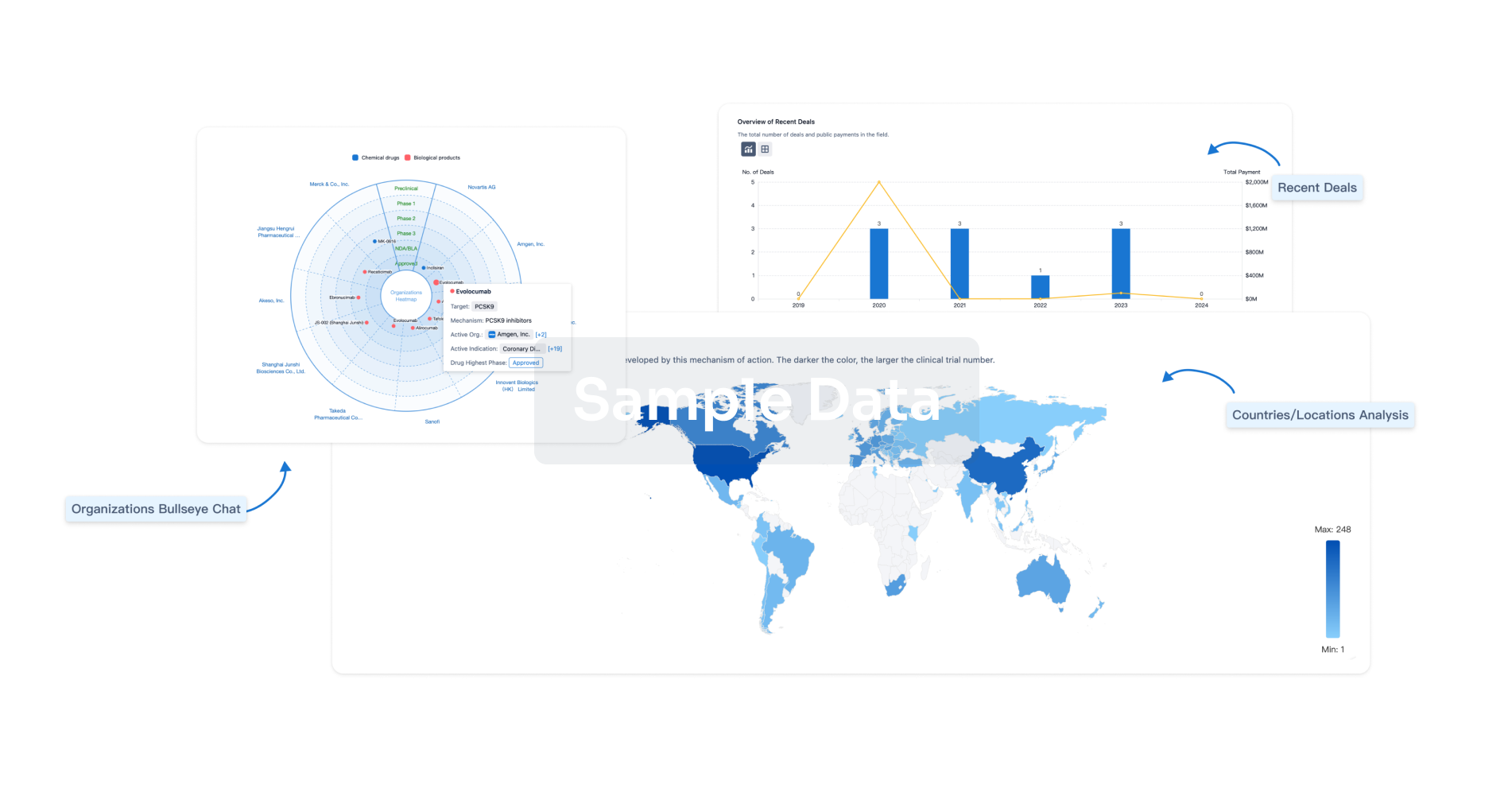Request Demo
Last update 08 May 2025
NET x α-adrenergic receptor x DAT
Last update 08 May 2025
Basic Info
Related Targets |
Related
1
Drugs associated with NET x α-adrenergic receptor x DATMechanism DAT antagonists [+2] |
Active Org. |
Originator Org. |
Active Indication |
Inactive Indication- |
Drug Highest PhaseApproved |
First Approval Ctry. / Loc. United States |
First Approval Date02 Mar 2021 |
7
Clinical Trials associated with NET x α-adrenergic receptor x DATCTR20242145
一项在中国健康成人受试者中评价AK0901空腹状态单次给药的药代动力学、安全性和耐受性的随机、开放标签、平行对照的1期临床研究
[Translation] A randomized, open-label, parallel-controlled Phase 1 clinical study to evaluate the pharmacokinetics, safety and tolerability of a single dose of AK0901 in the fasting state in healthy Chinese adult subjects
评估中国健康成人受试者单次口服AK0901的PK、安全性和耐受性。
[Translation]
To evaluate the PK, safety, and tolerability of a single oral dose of AK0901 in healthy Chinese adult subjects.
Start Date24 Jun 2024 |
Sponsor / Collaborator |
CTR20240367
一项在注意缺陷多动障碍6~12岁儿童受试者中研究 AK0901 胶囊口服给药的有效性、安全性、耐受性的多中心、随机、双盲、安慰剂对照Ⅲ期研究
[Translation] A multicenter, randomized, double-blind, placebo-controlled phase III study to investigate the efficacy, safety, and tolerability of oral AK0901 capsules in children aged 6 to 12 years with attention deficit hyperactivity disorder
评估 AK0901 与安慰剂相比在 6~12 岁 ADHD 儿童受试者中的疗效。评估 AK0901 与安慰剂相比在 6~12 岁 ADHD 儿童受试者中的安全性和耐受性。
[Translation]
To evaluate the efficacy of AK0901 compared with placebo in pediatric subjects aged 6-12 years with ADHD. To evaluate the safety and tolerability of AK0901 compared with placebo in pediatric subjects aged 6-12 years with ADHD.
Start Date28 May 2024 |
Sponsor / Collaborator |
NCT06359899
A Multicenter, Randomized, Double-blind, Placebo-controlled Phase III Study to Investigate the Efficacy, Safety and Tolerability of Oral Administered AK0901 Capsules in Children Aged 6-12 Years Old With Attention Deficit Hyperactivity Disorder
This study is a Phase 3, multicenter, dose-optimized, double-blind, randomized, placebo-controlled study designed to evaluate the efficacy, safety, and tolerability of oral AK0901 capsules in children 6 to 12 years old with Attention Deficit Hyperactivity Disorder(ADHD).
Start Date01 May 2024 |
Sponsor / Collaborator |
100 Clinical Results associated with NET x α-adrenergic receptor x DAT
Login to view more data
100 Translational Medicine associated with NET x α-adrenergic receptor x DAT
Login to view more data
0 Patents (Medical) associated with NET x α-adrenergic receptor x DAT
Login to view more data
15
Literatures (Medical) associated with NET x α-adrenergic receptor x DAT01 Aug 2023·Seminars in Oncology Nursing
Neurotransmitter Gene Polymorphisms Are Associated with Symptom Clusters in Patients Undergoing Radiation Therapy
Article
Author: Oppegaard, Kate ; Cooper, Bruce A ; Levine, Jon D ; Conley, Yvette ; Paul, Steven M ; Calvo-Schimmel, Alejandra ; Morse, Lisa ; Miaskowski, Christine ; Kober, Kord M ; Harris, Carolyn ; Shin, Joosun
01 Jan 2023·Pharmacogenomics
Pharmacogenetics of Anxiety and Depression in Alzheimer’s Disease
Review
Author: Naidoo, Vinogran ; Muñiz, Adriana ; Pego, Rocío ; Corzo, Lola ; Carril, Juan C ; Cacabelos, Ramón ; Martínez-Iglesias, Olaia ; Alcaraz, Margarita ; Cacabelos, Natalia
01 Feb 2020·Journal of traditional Chinese medicine = Chung i tsa chih ying wen pan
Mechanism underpinning effects of Shichangpu (Rhizoma Acori Tatarinowii) on attention deficit hyperactivity disorder.
Article
Author: Wang, Junhong ; Chou, Yiqian ; Feng, Kai ; Ren, Xinxin ; Zhao, Ying ; Yu, Qingyang ; Li, Ling
Analysis
Perform a panoramic analysis of this field.
login
or

AI Agents Built for Biopharma Breakthroughs
Accelerate discovery. Empower decisions. Transform outcomes.
Get started for free today!
Accelerate Strategic R&D decision making with Synapse, PatSnap’s AI-powered Connected Innovation Intelligence Platform Built for Life Sciences Professionals.
Start your data trial now!
Synapse data is also accessible to external entities via APIs or data packages. Empower better decisions with the latest in pharmaceutical intelligence.
Bio
Bio Sequences Search & Analysis
Sign up for free
Chemical
Chemical Structures Search & Analysis
Sign up for free

